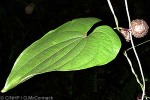Cook Islands Biodiversity Database
Species Page
Dioscorea bulbifera
‘OiAir-Potato
Multimedia & Additional Resources
| Type | Description | Download |
| Fruit and leaves | 57KB |
General Information
Cook Islands Distribution
| Southern Group: Present Makatea: Present | ||||||||
RR |
MG |
AT |
MK |
MT |
AK |
PL |
TK |
MN |
+++ |
+++ |
P |
P |
P |
++ |
- |
- |
|
| Northern Group: | |||||
TN |
MH |
RK |
PK |
NS |
SW |
- |
- |
- |
- |
- |
- |
Scientific Taxonomy
Dioscorea bulbifera Linnaeus
SYNONYMS: Dioscorea sativa [sensu TC]
TAXONOMY: PLANTAE; ANTHOPHYTA (=Angiospermae); LILIOPSIDA (=Monocotyledones); LILIIDAE; Liliales; DIOSCOREACEAE
More Information
SIGNIFICANCE NOTES -
POSITIVE SIGNIFICANCE: Food (former Root)
NEGATIVE SIGNIFICANCE: Poisonous to eat raw - serious. Comments: In Asia detoxification methods, involving water extraction, fermentation and roasting of the grated tuber are used for bitter cultivars of this yam. The bitter principles of D. bulbifera include a 3furanoside norditerpene called diosbulbin. These substances are toxic, causing paralysis. Extracts are sometimes used in fishing to immobolize the fish and thus facilitate capture. Toxicity may also be due to saponins in the extract. Zulus use this yam as bait for monkeys and hunters in Malaysia use it to poison tigers. In Indonesia an extract of D. bulbifera is used in the preparation of arrow poison (Coursey, 1967).
Vouchers & References
Vouchers:
None Recorded.
References:
p.1437 Wagner et al.- Flowering Plants of Hawaii
p.230 Neal - In Gardens of Hawaii
p.393 Tropica
p.1/168 A.C.Smith - Flora Vitiensis Nova
p.299 A Cheeseman - Flora of Rarotonga
p.31 Wilder - Flora of Rarotonga
p.385d Whistler - Ethnobotany of the Cook Islands
p.87 McCormack/Kunzle - Rarotonga's Mountain Tracks and Plants
Data Update History (information):
zTX, zB02, zM02, zupM05a, zD02
Web Resources
Citation Information
McCormack, Gerald (2007) Cook Islands Biodiversity Database, Version 2007.2. Cook Islands Natural Heritage Trust, Rarotonga. Online at http://cookislands.bishopmuseum.org. ![]()
Please refer to our use policy.

